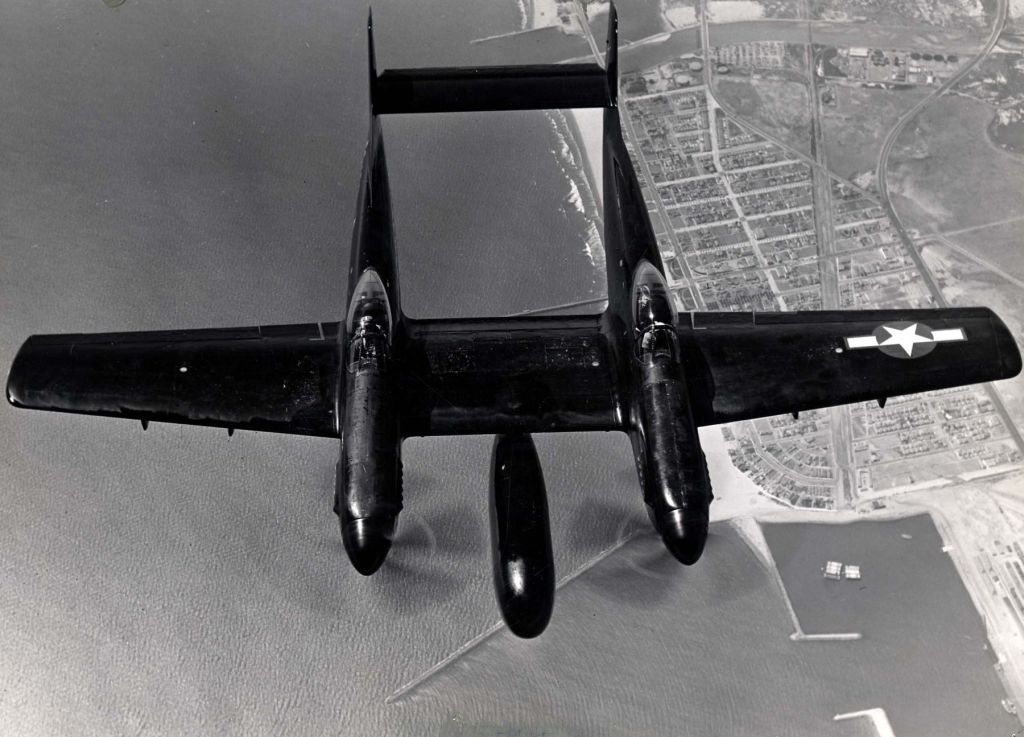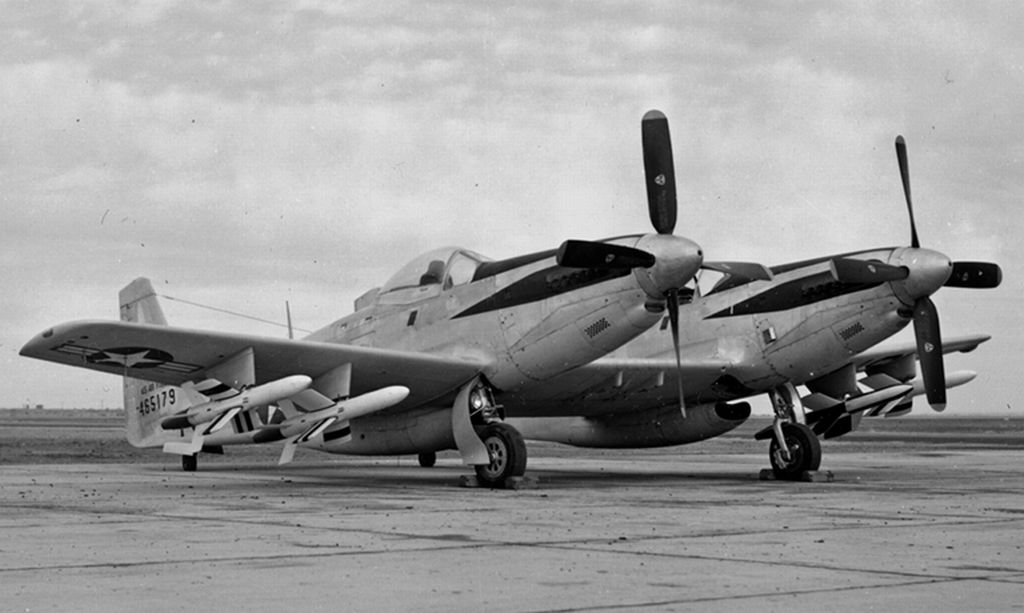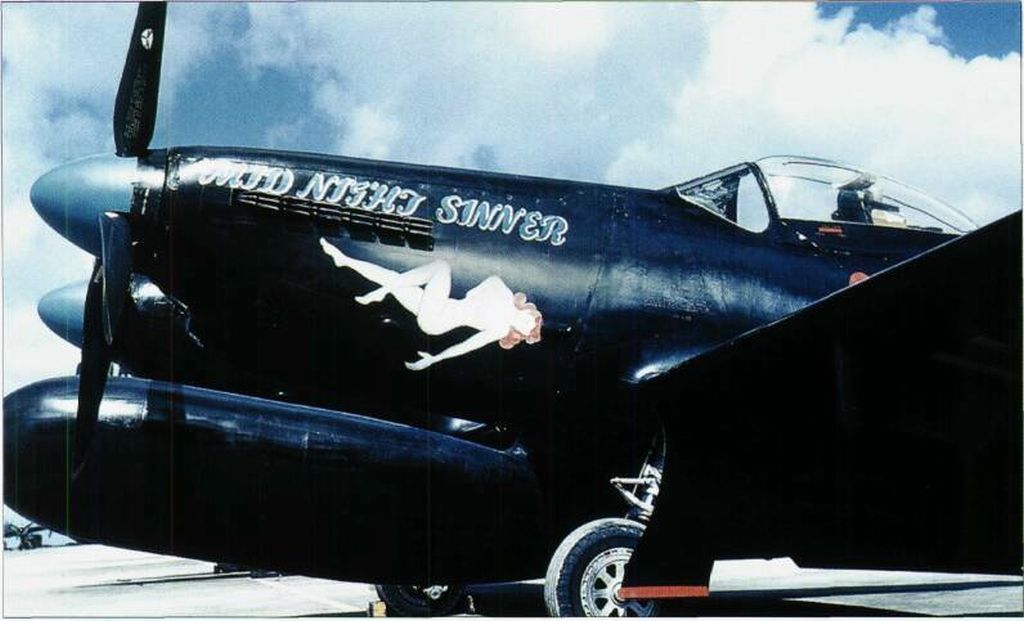Forums
- Forums
- Duggy's Reference Hangar
- USAAF / USN Library
- F-82 Twin Mustang
F-82 Twin Mustang
Post a reply
- Go to Previous topic
- Go to Next topic
- Go to Welcome
- Go to Introduce Yourself
- Go to General Discussion
- Go to Screenshots, Images and Videos
- Go to Off topic
- Go to Works in Progress
- Go to Skinning Tips / Tutorials
- Go to Skin Requests
- Go to IJAAF Library
- Go to Luftwaffe Library
- Go to RAF Library
- Go to USAAF / USN Library
- Go to Misc Library
- Go to The Ops Room
- Go to Made in Germany
- Go to Campaigns and Missions
- Go to Works in Progress
- Go to Juri's Air-Raid Shelter
- Go to Campaigns and Missions
- Go to Works in Progress
- Go to Skinpacks
- Go to External Projects Discussion
- Go to Books & Resources
-
12 years agoSat Aug 26 2023, 10:48amDuggy
 Main AdminText by Greg Goebel (Thanks)
Main AdminText by Greg Goebel (Thanks)
[3.1] TWIN MUSTANG: XP-82 & XP-82A / P-82B / P-82C & P-82D
* The long range of the Mustang led to a problem that hadn't been appreciated in earlier fighters: pilot exhaustion on long-range escort missions. Sitting in a relatively tight cockpit for six or seven hours, nursing a powerful aircraft along, and enduring the anxiety and stress of air combat was enough to drain a pilot completely. Sometimes pilots had to be helped out of the cockpit when they returned to base, and the combination of murky English weather and pilot fatigue often led to accidents.
The USAAF was interested in a fighter with even longer range than the P-51D to operate over the wide expanses of the Pacific, particularly as an escort for the long-range Boeing B-29 Superfortress bomber. The need to deal with pilot fatigue and provide longer range meant a twin-engine, two-seat aircraft, but traditionally twin-engine fighters were no match for single-engine fighters.
In November 1943, NAA's Edgar Schmued came up with an interesting proposal to address the problem: link two Mustangs together with a common center wing and horizontal stabilizer. He had actually been tinkering with the idea as far back as 1940. On 7 January 1944, Hap Arnold visited NAA's Inglewood factory and was shown the concept. Arnold was enthusiastic, and gave NAA the go-ahead to proceed for the design, which the company designated "NA-120". In early February 1944, the USAAF ordered four flight prototypes and a static test item of the new design. Two of the flight prototypes were designated "XP-82s" and were to be powered by variants of the Packard V-1650 Merlin, and two were designated "XP-82As", to be powered by variants of the improved Allison V-1710-119 engine with two-stage supercharging.
The first of two XP-82s flew on 16 June 1945, with NAA test pilot Joe Barton at the controls. Barton had actually tried to make the first flight on 25 May, but the machines absolutely refused to get off the runway, and the first actual flight was performed with a half-fuel load. The design engineers were frantic, thinking that the machine was fundamentally flawed, but it turned out that the engines, which contrarotated, had been installed so that the props swept upward towards the center wing section, which stalled the wing section. The engines were quickly reversed, and on 26 June the XP-82 took off and flew more or less as it had been designed to, much to everyone's relief. Only one of the XP-82As was actually completed, and was rolled out in the late summer of 1945.
The common center wing section housed all the XP-82's gun armament, consisting of six 12.7 millimeter Browning machine guns with 440 rounds per gun. The center wing section featured a slotted flap running the length of the trailing edge. The wing area of the XP-82 was substantially less than that of two Mustangs, and so the wing had to be strengthened to handle higher wing loading. Longer two-piece ailerons with hydraulic power boosting were fitted to the outer wings to improve roll response.
The XP-82 could be fitted with a total of six stores pylons, two on each outer wing and two on the center wing section, for bombs, HVAR rockets, or drop tanks. Up to 1,800 kilograms (4,000 pounds) of stores could be carried. The center section could also carry a pod for night-fighting radar, machine guns, or reconnaissance cameras. Radar pods would receive further development, as explained below. A gun pod carrying eight 12.7 millimeter Browning guns was developed, but never fielded. A reconnaissance pod was apparently built, but saw little or no use.
The XP-82 was big, 3.1 meters (10 feet 2 inches) longer than a P-51D, and the dorsal fin extension was enlarged to improve yaw stability. There was actually very little parts compatibility between the XP-82 and a single-engine Mustang. The XP-82 had fuel tanks in the outer wings and in each fuselage, giving it a big internal fuel capacity of 2,180 liters (574 US gallons), and correspondingly long range. As mentioned, the twin Packard Merlin engines of the XP-82 rotated in opposite directions, in order to compensate for torque, and so the aircraft was fitted with left-handed and right-handed engines, designed "V-1650-23" and "V-1650-25".
Landing gear had to be revised and strengthened to handle the greater weight. The main gear was hinged in the fuselage, and retracted across the fuselage into the common center wing. The fuselage tailwheel was retained, giving the Twin Mustang an unusual "four point" stance on the ground. The cockpits were largely redesigned from the single-seat Mustang. The command pilot flew in the left cockpit, which was fully equipped. The copilot occupied the right cockpit, with more austere controls to allow him to spell the copilot when need be. An interceptor version with one cockpit faired over was considered, but nothing came of the idea.
The XP-82A was generally identical to the XP-82, except for Allison engine fit. As with the XP-82, the engines had to be provided in "left handed" and "right handed" versions, and were produced as the "V-1710-143" and "V-1710-144".
* The initial XP-82 prototypes demonstrated impressive performance in early tests. The new aircraft had a top speed of 776 KPH (482 MPH) and a range on internal tanks of 2,237 kilometers (1,390 miles). With four drop tanks installed, the range was 5,550 kilometers (3,445 miles).
The USAAF had enough confidence in North American to order 500 "P-82B Twin Mustangs" in March 1944, well before the XP-82's first flight. These were Packard Merlin powered aircraft, identical to the XP-82 except for improved machine guns. The contract was cut at the end of the war, and only 20 were actually delivered, in late 1945 and early 1946. These aircraft were used for training and evaluation, except for two of them that were diverted for experiments.








On 28 February 1947, a P-82B named BETTY JO, the ninth production item, piloted by Lieutenant Colonel Robert Thacker (Betty Jo was his wife) and Lieutenant John Ard, set a record for unrefueled flight in a piston fighter, flying from Hickam Field in Hawaii to La Guardia Airport in New York in about 14.5 hours. This aircraft had been stripped down, modified with additional internal fuel tanks, and fitted with four oversized 1,150 liter (310 US gallon) drop tanks. The total distance covered was 7,998 kilometers (4,968 miles) and the average speed was 559 KPH (347 MPH). That was faster than the top speed of most combat aircraft at the beginning of WW II.
* The two aircraft that had been diverted from production were modified as prototype night fighters, with the designations "XP-82C" and "XP-82D". Both aircraft featured a search radar enclosed in a pod on the center wing section. Since the radar had to be set in front of the propellers to ensure that it had a clear field of view, the pod was very long and mounting it was troublesome. The pod was referred to as a "pickle" or a "dong". The XP-82C carried SCR-720C search radar, which had been used on the Northrop P-61 Black Widow night fighter. The XP-82D carried the less powerful but lighter, and so less difficult to mount, AN/APS-4 radar. Radar operator gear was installed in the right cockpit.
The P-82B and its experimental night-fighter derivatives were the last Merlin Mustangs produced. The last Merlin-powered Twin Mustang would be withdrawn from service in December 1949.








[3.2] TWIN MUSTANG: F-82E / F-82F, F-82G, & F-82H
* While the Merlin-powered Twin Mustangs derived from the XP-82 were only used experimentally or as trainers, the USAAF went ahead to production and operational use of derivatives of the Allison-powered XP-82A.
The USAAF knew that the jet fighter was the way of the future, but early jets didn't have the range for long-range escort missions. In February 1946, the USAF ordered 250 Allison-powered "P-82Es" as interim long-range escort fighters. The order was soon changed to 100 P-82Es, plus 150 night-fighter versions of the Twin Mustang, as detailed below. First flight of the P-82E was on 17 February 1947. In 1947, the US Army Air Forces became the US Air Force, and fighters were redesignated with an "F" for "fighter" instead of the archaic "P" for "pursuit". All P-82s became "F-82s" as a result.
Production F-82Es were slow in arriving, the problem being the updated Allison V-1710 engine. The Allison was selected because Packard had to pay Rolls-Royce a $6,000 USD royalty for every V-1650 the company produced. During the war, Rolls Royce had been lenient about license fees, but after the end of the conflict, Britain's economy was in the dumps and the royalty fee skyrocketed. There was also the fact that General Motors, which owned Allison, had a 40% share in NAA. GM had not been happy with the Mustang's switch to Merlin power during the war, but demand for Allisons by other aircraft such as the P-38 Lightning was strong and GM had not been in a position to protest. With the war over, aircraft production took a dive and GM wanted to sell more Allisons. There were few other reasons to use the Allison engine, since even the two-stage supercharged Allison V-1710 was inferior in power-to-weight ratio to the Merlin.
The souped-up Allison engine was also temperamental and unreliable, and Allison couldn't deliver product in quantity. NAA had completed the 100 F-82E airframes by April 1948, but wasn't able to deliver them all for another year due to engine shortages. In service, the Allison-powered F-82Es were marginally slower than the Merlin-powered F-82Bs and the reliability problems persisted. The V-1710 became known as the "Allison time bomb" due to engine failures. Spark plug fouling from backfiring was particularly acute, and spark plugs were often swapped after a single flight.
NAA engineers modified some Allison engines with Merlin components and fixed most of the problems, but Allison took a "not invented here" attitude and insisted on applying their own fixes, which never quite worked. Given the small production run of the Twin Mustang, even the steep license fee Rolls Royce was demanding for the Merlin was a bargain compared to all the troubles the USAF had with the Allisons. Pilots still found the machine pleasant to fly because its performance was so good even when its engines couldn't be run at their top ratings; in fact, they could lose an engine and hardly notice it. The Twin Mustang was also very agile for an aircraft of its size, and was a very stable gun platform. The battery of guns mounted in the center wing section provided highly focused firepower.
The F-82Es were externally indistinguishable from the F-82As except for minor details. One of the giveaways was the engine exhaust stacks. On the Merlin-powered aircraft, there were six exhaust stacks on each side. On the Allison-powered aircraft, there were duplicate exhaust stacks for each cylinder, for a total of 12 exhaust stacks on each side.
The F-82Es were assigned to Strategic Air Command and flew long-range demonstration missions to show off their capabilities, but they were an interim type indeed. Phaseout began in March 1950, less than a year after the last one was delivered, and was completed by July. Mid-air refueling promised to give jet fighters the range they needed to do the Twin Mustang's long-range escort job.
* The night-fighter versions of the Twin Mustang achieved a bit more distinction in service. In September 1946, the USAAF had ordered 100 "P-82Fs" with AN/APG-28 radar, an improved version of the AN/APS-4 radar used on the P-82D, and 50 "P-82Gs" with SCR-720C radar. These aircraft were Allison powered. Interesting, the big radar pod imposed little performance penalty. The F-82Fs and F-82Gs, as they would be known in service, also featured radar beacons, plus AN/APS-13 tail warning radar.
Before either type was delivered, the USAAF came up with a new requirement for an all-weather fighter for operations in Alaska. Nine F-82Fs were refitted with the SCR-720C radar, essentially turning them into F-82Gs, and both these aircraft and five F-82Gs were fitted with cold-weather gear, including improved heating systems. These were known as "F-82Hs", and were the last Mustangs ever produced by NAA.
NORTH AMERICAN F-82G TWIN MUSTANG:
_____________________ _________________ _______________________
spec metric english
_____________________ _________________ _______________________
wingspan 15.62 meters 51 feet 3 inches
wing area 37.9 sq_meters 408 sq_feet
length 12.92 meters 42 feet 5 inches
height 4.21 meters 13 feet 10 inches
empty weight 7,256 kilograms 15,997 pounds
max loaded weight 11,744 kilograms 25,891 pounds
maximum speed 740 KPH 460 MPH / 400 KT
service ceiling 11,857 meters 38,900 feet
combat radius 1,634 KM 1,015 MI / 885 NMI
_____________________ _________________ _______________________
The night-fighter Twin Mustangs went into service primarily as interim replacements for the P-61 Black Widow until jet night fighters were available. These Twin Mustangs soldiered on a few more years, until the F-82Hs were finally withdrawn in 1953. They were the last prop-driven air-combat fighters in service with the USAF.
During their short lifetime, the F-82s achieved one major distinction: holding the fort in Korea until reinforcements arrived. Three squadrons of F-82Gs were operating in Japan as part of the 347th Fighter (All Weather) Group, when North Korea invaded South Korea on 25 June 1950. The F-82Gs were the only aircraft available in Japan that had sufficient endurance to fly to the battle area and operate for hours over the evacuation centers at Kimpo and Inchon. On 27 June, Lieutenant William Hudson and his radar operator, Lieutenant Carl Fraser, scored the first air-to-air kill of the Korean War, shooting down a Lavochkin La-11. Lieutenant Charles Moran shot down a Yakovlev Yak-9 a short time later, and Major James Little increased the day's score to three by destroying a Lavochkin La-7.
The North Korean Air Force had no advanced jet aircraft at the time, and the F-82Gs and Lockheed F-80 Shooting Stars quickly cleaned the North Koreans out of the sky. The F-82Gs switched their mission from air combat to night interdiction, using bombs and HVAR rockets to destroy North Korean armor and other targets.
Eventually, the night interdiction mission was taken over by the Douglas B-26 Invader, which was more heavily armed and better suited to the role. The last assignment of the F-82Gs in Korea was to hunt down low-flying Polikarpov PO-2 biplanes that the North Koreans used for night harassment raids, but this was an exercise in frustration since the nimble biplanes were almost impossible to find, much less shoot down. The F-82Gs were finally replaced by Lockheed F-94B Starfires in 1952.
A LINK -- http://xp-82twinmustangproject.blogspot.ca/p/home_17.html
Production.



Enjoy the rest.














































Regards Duggy
-
 AdminBetty Jo a couple years ago in the NMUSAF
AdminBetty Jo a couple years ago in the NMUSAF

Post a reply
- Go to Previous topic
- Go to Next topic
- Go to Welcome
- Go to Introduce Yourself
- Go to General Discussion
- Go to Screenshots, Images and Videos
- Go to Off topic
- Go to Works in Progress
- Go to Skinning Tips / Tutorials
- Go to Skin Requests
- Go to IJAAF Library
- Go to Luftwaffe Library
- Go to RAF Library
- Go to USAAF / USN Library
- Go to Misc Library
- Go to The Ops Room
- Go to Made in Germany
- Go to Campaigns and Missions
- Go to Works in Progress
- Go to Juri's Air-Raid Shelter
- Go to Campaigns and Missions
- Go to Works in Progress
- Go to Skinpacks
- Go to External Projects Discussion
- Go to Books & Resources
